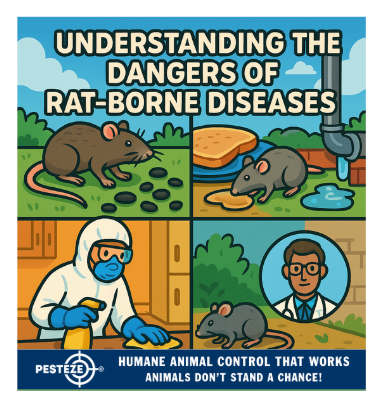UNDERSTANDING THE DANGERS OF RAT-BORNE DISEASES

UNDERSTANDING THE DANGERS OF RAT-BORNE DISEASES
SUMMARY
This guide explains the main health risks associated with rats, how infections are commonly transmitted, and practical steps to reduce exposure. It emphasizes prevention, safe cleanup, when to seek medical help, and when to involve professionals.
FEATURES
-
Common Diseases: Highlights of the illnesses rats most often carry.
-
How Transmission Happens: Routes such as droppings, urine, bites, and contaminated food/water.
-
Recognize Symptoms: What to watch for after possible exposure.
-
Safe Cleanup & Prevention: Concrete steps to reduce risk at home.
-
When to Get Help: Guidance on medical care and professional pest control.
-
Community & Legal Considerations: Reporting and public-health coordination.
GUIDE DESCRIPTION
Rats can carry a range of pathogens that pose real health risks to people and pets. Common rat-associated diseases include illnesses spread through inhalation or contact with droppings and urine (for example, hantavirus or leptospirosis), foodborne infections from contamination (such as salmonella), and infections resulting from bites or scratches (for example, rat-bite fever). Although not every rat carries every pathogen, any infestation increases the chance of exposure—so prevention and cautious handling matter.
Transmission usually occurs in a few predictable ways. Droppings and urine on floors, in cupboards, and in attics can dry and aerosolize, making inhalation a risk during cleanup. Contaminated surfaces or food lead to ingestion risks. Direct contact through a bite or scratch can introduce bacteria into the body, and water or soil contaminated with rodent urine can expose people and animals to bacteria like Leptospira. Knowing these routes helps you minimize them.
If you suspect exposure, watch for symptoms—but don’t panic. Early signs vary by disease: flu-like symptoms (fever, muscle aches, headache) are common to many, while gastrointestinal symptoms (nausea, diarrhea) suggest foodborne infection, and jaundice or severe muscle pain could indicate leptospirosis. After a possible exposure (e.g., a bite, heavy droppings cleanup without protection, or direct contact with rodent urine), seek medical advice—especially if you develop fever, unusual fatigue, breathing trouble, or persistent gastrointestinal symptoms. Prompt medical evaluation improves outcomes and helps determine if testing or treatment (like antibiotics) is needed.
Prevention and safe cleanup are the best defenses. Exclude rodents by sealing entry points, store food in rodent-proof containers, keep garbage secured, and reduce clutter that provides nesting sites. When cleaning areas with droppings or nests, ventilate the space for at least 30 minutes, avoid sweeping or vacuuming dry droppings, and use gloves plus a respirator or mask (N95). Wet surfaces with a bleach solution or household disinfectant, let it soak, then wipe up with disposable towels and dispose of waste in sealed bags. Wash hands thoroughly after handling traps, garbage, or cleaning materials.
Large or persistent infestations, structural damage, or suspected disease outbreaks require professional help. Licensed pest-control operators use integrated pest management to remove rodents safely and advise on sanitation and exclusion. Notify local public-health authorities if you find multiple sick or dead animals, or if several people in one household become ill after suspected exposure—public-health teams can investigate and offer guidance.
By combining exclusion, careful sanitation, timely medical attention after exposures, and professional control when needed, you can greatly reduce the health risks associated with rats while protecting your family and community.
- Saneeth Thota


Comments 0